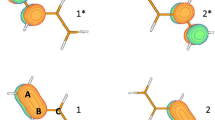Abstract
Experimental evidence for strong electron-electron interactions in polyacetylene is presented. These include (i) observation of a dipole forbidden state below the optical gap, (ii) observation of negative spin densities at sites at which noninteracting models predict zero spin density (iii) vanishing optical gap, in the infinite chain limit, in the closely related symmetrical linear cyanine dyes. To correctly explain these features it is necessary to solve correlated model Hamiltonians. Using diagrammatic valence bond method model exact solutions of correlated models of finite-size systems can be obtained and various physical properties of the low-lying states can be computed. These properties, when extrapolated to the infinite chain limit explain many of the experimental features observed in polyacetylene.
Similar content being viewed by others
References
Brooker L G S, Sklar A L, Cressman H W J, Keyes G H, Smith L A, Sprague R H, Van Lare E, Van Zandt G, White F L and Williams W W 1945J. Am. Chem. Soc. 67 1875
Bychkov L A, Gorkov L P and Dzyaloshinskii I E 1966Zh. Eksp. Teor. Fiz. 50 738 [1966Soc. Phys.-JETP 23 489]
Chui S T and Bray J W 1978Phys. Rev. B18 2426
Cizek J, Paldus J and Srobkova L 1969Int. J. Quant. Chem. 3 149
Coulson C A 1938Proc. R. Soc. London A164 383
Fincher Jr. C R, Chen C E, Heeger A J and MacDiarmid A G 1982Phys. Rev. Lett. 48 100
Fukutome H and Sasai M 1982Prog. Theor. Phys. 67 41
Goldberg I B, Crowe H R, Newman P R, Heeger A J and MacDiarmid A G 1979J. Chem. Phys. 70 1132
Hirsch J E, Sugar R L, Scalapino D J and Blankenbecler R 1982Phys. Rev. B26 5033
Honig B, Warshel A and Karplus M 1975Acc. Chem. Res. 8 92
Hudson B S, Kohler B E and Schulten K 1982 inExcited states (ed.) E C Lim (New York: Academic Press) vol. 6
Kivelson S and Heim D 1982Phys. Rev. B26 4278
Kuhn H 1948Helv. Chim. Acta 31 1441
Leib E H and Wu F Y 1968Phys. Rev. Lett. 20 1445
Longuet-Higgins H C and Salem L 1959Proc. R. Soc. London A25 172
Matsen F A 1978Acc. Chem. Res. 11 387
Mazumdar S and Campbell D K 1985Phys. Rev. Lett. 55 2067
Mazumdar S and Dixit S N 1983Phys. Rev. Lett. 51 292
Mazumdar S and Dixit S N 1984Phys. Rev. B29 1824
Mazumdar S and Soos Z G 1979Synth. Metals 1 77
McConnel H M and Chesnut D B 1957J. Chem. Phys. 27 984
Murrel J N 1963The theory of electronic spectra of organic molecules (London: Wiley)
Ohmine I, Karplus M and Schulten K 1978J. Chem. Phys. 68 2298
Ohno K 1964Theor. Chim. Acta 2 219
Ovchinnikov A A, Ukrainski I I and Kventsel G V 1972Usp. Fiz. Nauk. 108 51 [1973Sov. Phys. Usp. 15 575]
Pauling L 1933J. Chem. Phys. 1 280
Peierls R E 1955Quantum theory of solids (Oxford: Clarendon) p. 109
Platt J R 1956J. Chem. Phys. 25 80
Pople J A and Walmsley S H 1962Mol. Phys. 5 15
Ramasesha S and Soos Z G 1983Solid State Commun. 46 409
Ramasesha S and Soos Z G 1984aInt. J. Quant. Chem. 25 1003
Ramasesha S and Soos Z G 1984bJ. Chem. Phys. 80 3278
Ramasesha S and Soos Z G 1985Phys. Rev. B32 5368
Roomany H H, Wyld H W and Holloway L E 1980Phys. Rev. D21 1557
Salem L 1966The molecular orbital theory of conjugated systems (New York: Benjamin)
Soos Z G and Ramasesha S 1983aChem. Phys. Lett. 101 34
Soos Z G and Ramasesha S 1983bPhys. Rev. Lett. 51 2374
Soos Z G and Ramasesha S 1984Phys. Rev. B29 5410
Su W P, Schrieffer J R and Heeger A J 1979Phys. Rev. Lett. 42 1698
Su W P, Schrieffer J R and Heeger A J 1980Phys. Rev. B22 2099
Thomann H, Dalton L R, Tomkiewicz Y, Shiren N S and Clarke T C 1983Phys. Rev. Lett. 50 553
Yannoni C S and Clarke T C 1983Phys. Rev. Lett. 51 1191
Author information
Authors and Affiliations
Additional information
Communication No. 349 from the Solid State and Structural Chemistry Unit.
Rights and permissions
About this article
Cite this article
Ramasesha, S. Electron-electron interactions in polyacetylene. Proc. Indian Acad. Sci. (Chem. Sci.) 96, 509–521 (1986). https://doi.org/10.1007/BF02936302
Issue Date:
DOI: https://doi.org/10.1007/BF02936302




